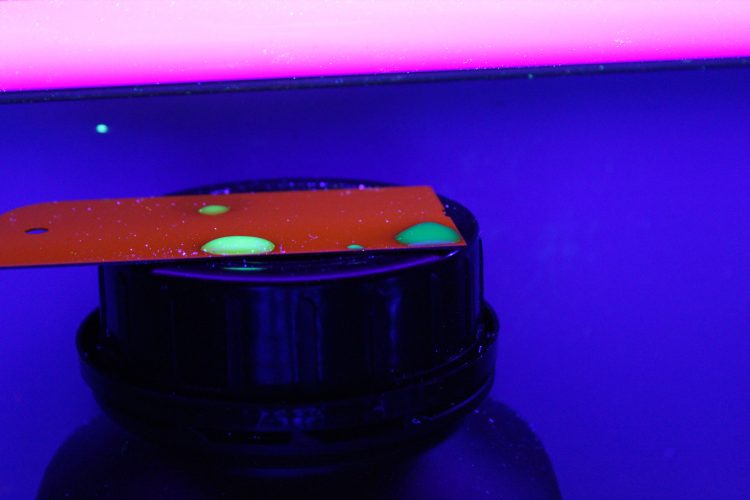Chemochromic Materials: pigments, inks, paints
Are you looking for a material that changes color under the effect of a gas or a solvent?
OliKrom is an internationally renowned company in the field of intelligent materials.
We design and produce a new generation of smart materials (pigment, dye, paint, ink,...) sensitive to the presence of water (hydrochromic), solvent (solvatochromic), gas (chemochromic).
15 years of expertise in color intelligence
Our teams master the most advanced scientific concepts in photochemistry, materials science, thermodynamics and phase transition. This know-how allows us to develop your custom-made material for a dedicated surface deposition. We select the most suitable technology to meet your industrial specifications.
On a daily basis, our teams of researchers and engineers develop new methods for the synthesis of pigments or dyes. We adapt formulations (ink, paint) to improve the intelligent property, the detection threshold of a product, the visibility on a surface and the durability in the industrial environment.
Depending on your project, we design and produce two classes of materials that change color in the presence of a solvent (solvatochromic, hydrochromic) or a gas (chemochromic).
Solvatochromic materials

Reversible or irreversible color change in the presence of water (hydrochromic) and/or solvent (solvatochromic). Modulation of the sensitivity threshold, degree of humidity, of the luminescence property.
Applications : leak detection, anti-counterfeiting, industrial marking, etc.
Chemochromic materials

Color change under the influence of a gas. OliKrom adapts the color change threshold to the nature of the gas.
Applications: detection of a gas leak on an industrial site, control marking for the storage of hazardous materials, etc.
Our experts are at your side "from the first idea to the final product". Three departments have been created to intervene effectively at each stage of your project: research and development, pre-industrialization and industrialization.
From experience, we know the main pitfalls encountered with chemochromic, hydrochromic and/or solvatochromic materials: the need to adapt the color contrast of the product, the speed of color change and fading too slow or too fast, the degradation of properties during formulation and/or the industrial process, the sensitivity to ultraviolet light, etc.
Solvatochromic and hydrochromic coatings

In the fields of industrial safety and predictive maintenance (energy, petrochemical, nuclear...), the applications of solvatochromic coatings are varied. The color modification of an ink and/or paint allows direct monitoring of a solvent leak, the presence of moisture and/or water (hydrochromic property), a pH variation. The color change can also be used to indicate a water leak between two control periods.
One of the reasons to use an smart color change coatings is often to substitute an electronic sensor in an environment where it is impossible to insert any electrical wiring, or to act without electricity, in total autonomy.
This type of request occurs in particular for the storage of sensitive materials for years. In this case, electrical autonomy is a requirement.
Chemochromic coatings

Many industrial fields select the use of color change materials to detect the presence of a gas (SO2, NO2, H2, CH4...). This color change approach has the advantage of being understandable by all, easy to use and to interpret.
In predictive maintenance and/or industrial safety, the applications are numerous. The need may be to access a detection on a large surface, an object or products in their entirety. This is the case, for example, to monitor the presence of a leak on a pipeline by drone. On the other hand, the use of an electronic detector would allow access to local information but not to a global cartography.
Another challenge could be the design of coatings capable of changing color in the event of a hydrogen leak, beyond the explosive threshold. Our Research Department is already developing initial solutions to support the deployment of this future green fuel.
Finally, the use of colored indicators is also being considered for air purifiers to indicate the need to replace the filtering system.
![]()
CONTACT US
We will get back to you as soon as possible..
"*" indicates required fields

